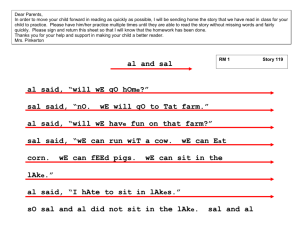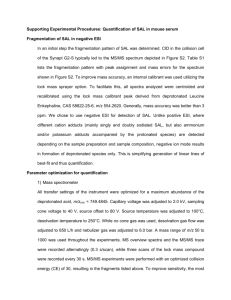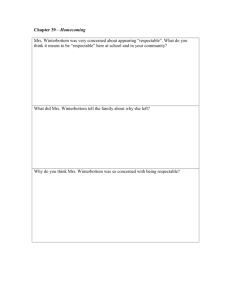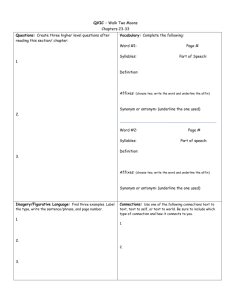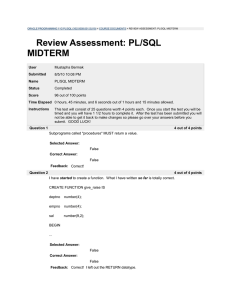PL/SQL Packages - TutorialsPoint
advertisement
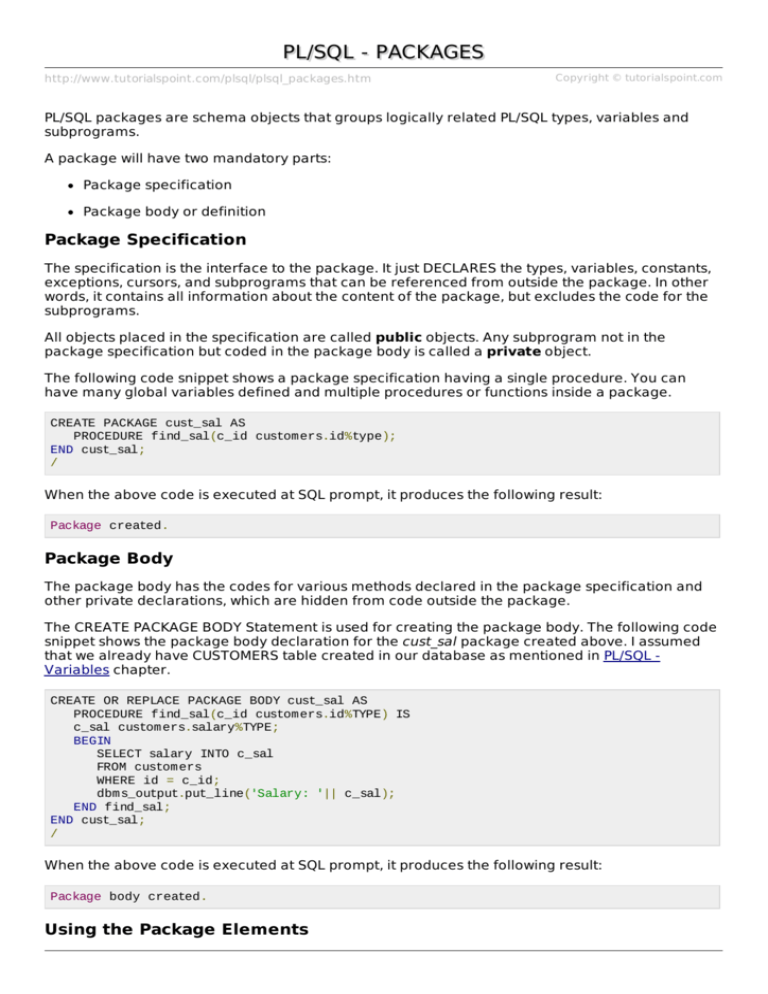
PL/SQL - PACKAGES
http://www.tutorialspoint.com/plsql/plsql_packages.htm
Copyright © tutorialspoint.com
PL/SQL packages are schema objects that groups logically related PL/SQL types, variables and
subprograms.
A package will have two mandatory parts:
Package specification
Package body or definition
Package Specification
The specification is the interface to the package. It just DECLARES the types, variables, constants,
exceptions, cursors, and subprograms that can be referenced from outside the package. In other
words, it contains all information about the content of the package, but excludes the code for the
subprograms.
All objects placed in the specification are called public objects. Any subprogram not in the
package specification but coded in the package body is called a private object.
The following code snippet shows a package specification having a single procedure. You can
have many global variables defined and multiple procedures or functions inside a package.
CREATE PACKAGE cust_sal AS
PROCEDURE find_sal(c_id customers.id%type);
END cust_sal;
/
When the above code is executed at SQL prompt, it produces the following result:
Package created.
Package Body
The package body has the codes for various methods declared in the package specification and
other private declarations, which are hidden from code outside the package.
The CREATE PACKAGE BODY Statement is used for creating the package body. The following code
snippet shows the package body declaration for the cust_sal package created above. I assumed
that we already have CUSTOMERS table created in our database as mentioned in PL/SQL Variables chapter.
CREATE OR REPLACE PACKAGE BODY cust_sal AS
PROCEDURE find_sal(c_id customers.id%TYPE) IS
c_sal customers.salary%TYPE;
BEGIN
SELECT salary INTO c_sal
FROM customers
WHERE id = c_id;
dbms_output.put_line('Salary: '|| c_sal);
END find_sal;
END cust_sal;
/
When the above code is executed at SQL prompt, it produces the following result:
Package body created.
Using the Package Elements
The package elements variables, proceduresorfunctions are accessed with the following syntax:
package_name.element_name;
Consider, we already have created above package in our database schema, the following program
uses the find_sal method of the cust_sal package:
DECLARE
code customers.id%type := &cc_id;
BEGIN
cust_sal.find_sal(code);
END;
/
When the above code is executed at SQL prompt, it prompt to enter customer ID and when you
enter an ID, it displays corresponding salary as follows:
Enter value for cc_id: 1
Salary: 3000
PL/SQL procedure successfully completed.
Example:
The following program provides a more complete package. We will use the CUSTOMERS table
stored in our database with the following records:
Select * from customers;
+----+----------+-----+-----------+----------+
| ID | NAME
| AGE | ADDRESS
| SALARY
|
+----+----------+-----+-----------+----------+
| 1 | Ramesh
| 32 | Ahmedabad | 3000.00 |
| 2 | Khilan
| 25 | Delhi
| 3000.00 |
| 3 | kaushik | 23 | Kota
| 3000.00 |
| 4 | Chaitali | 25 | Mumbai
| 7500.00 |
| 5 | Hardik
| 27 | Bhopal
| 9500.00 |
| 6 | Komal
| 22 | MP
| 5500.00 |
+----+----------+-----+-----------+----------+
THE PACKAGE SPECIFICATION:
CREATE OR REPLACE PACKAGE c_package AS
-- Adds a customer
PROCEDURE addCustomer(c_id
customers.id%type,
c_name customers.name%type,
c_age customers.age%type,
c_addr customers.address%type,
c_sal customers.salary%type);
-- Removes a customer
PROCEDURE delCustomer(c_id
--Lists all customers
PROCEDURE listCustomer;
customers.id%TYPE);
END c_package;
/
When the above code is executed at SQL prompt, it creates the above package and displays the
following result:
Package created.
CREATING THE PACKAGE BODY:
CREATE OR REPLACE PACKAGE BODY c_package AS
PROCEDURE addCustomer(c_id customers.id%type,
c_name customers.name%type,
c_age customers.age%type,
c_addr customers.address%type,
c_sal
customers.salary%type)
IS
BEGIN
INSERT INTO customers (id,name,age,address,salary)
VALUES(c_id, c_name, c_age, c_addr, c_sal);
END addCustomer;
PROCEDURE delCustomer(c_id
BEGIN
DELETE FROM customers
WHERE id = c_id;
END delCustomer;
customers.id%type) IS
PROCEDURE listCustomer IS
CURSOR c_customers is
SELECT name FROM customers;
TYPE c_list is TABLE OF customers.name%type;
name_list c_list := c_list();
counter integer :=0;
BEGIN
FOR n IN c_customers LOOP
counter := counter +1;
name_list.extend;
name_list(counter) := n.name;
dbms_output.put_line('Customer(' ||counter|| ')'||name_list(counter));
END LOOP;
END listCustomer;
END c_package;
/
Above example makes use of nested table which we will discuss in the next chapter. When the
above code is executed at SQL prompt, it produces the following result:
Package body created.
USING THE PACKAGE:
The following program uses the methods declared and defined in the package c_package.
DECLARE
code customers.id%type:= 8;
BEGIN
c_package.addcustomer(7, 'Rajnish', 25, 'Chennai', 3500);
c_package.addcustomer(8, 'Subham', 32, 'Delhi', 7500);
c_package.listcustomer;
c_package.delcustomer(code);
c_package.listcustomer;
END;
/
When the above code is executed at SQL prompt, it produces the following result:
Customer(1):
Customer(2):
Customer(3):
Customer(4):
Customer(5):
Customer(6):
Customer(7):
Ramesh
Khilan
kaushik
Chaitali
Hardik
Komal
Rajnish
Customer(8):
Customer(1):
Customer(2):
Customer(3):
Customer(4):
Customer(5):
Customer(6):
Customer(7):
Subham
Ramesh
Khilan
kaushik
Chaitali
Hardik
Komal
Rajnish
PL/SQL procedure successfully completed
Loading [MathJax]/jax/output/HTML-CSS/jax.js
